Languedoc. Land of three kisses. Everyone knows that the French greet each other with kisses on the cheek. However, the French kissing custom can garner intense confusion for visiting foreigners. Like a secret code that only locals are privy to, the number of kisses exchanged varies based on geography, ranging anywhere from 1 to 5 (!!) kisses. Observe:
As you may or may not know, my husband and I recently spent an amazing two months travelling from one end of the Mediterranean to the other. We started out in Portugal (I know, I know, not technically the Med, but Jamiroquai was playing a music festival and I absolutely had to go), then headed west, spending time in Spain, France, Italy, Greece and Cyprus. Yeah, sounds pretty rough, I am fully aware.
This post will focus on our first few days in France, which were spent in the Languedoc region, located on the Mediterranean side of the Southwest. When we arrived in Pignan, the small town near Montpellier where we would be staying, we were greeted by our hosts. It was time for the aforementioned preliminary greetings. Most of my family is from the Aix-en-Provence area, so I stopped at two kisses, but my host came in for more (land of three kisses!!), which is always somewhat awkward, like leaving a high five hanging mid-air. And then there’s the question of which side of the face to go for first. Whenever I arrive in France, I invariably choose the wrong side, and end up nearly locking lips with strangers.
Once the initial doorway pleasantries and associated awkwardness were over, we wasted no time diving right into the local food and wine customs. As an apéritif, we enjoyed a bottle of Miraflors Lafabuleuse, from Domaine Lafage (you may be familiar with their rosé, which flies off the shelves every summer). This slightly off-dry and effervescent white is a fantastic way to get those salivary glands going before a meal, and pairs well with many hors d’œuvres.

Lafage Miraflors Lafabuleuse
The outdoor fireplace you can see in the background above was where the magic happened, and created some of our most memorable meals while in Languedoc. That first night we were treated to the traditional brasucade, where mussels are marinated and slowly cooked over a wood fire. I can’t even begin to tell you how delicious it was. To the point where we ate standing around the table, ravenously eating mussels with our fingers. It made for an amazing first meal to celebrate our arrival.
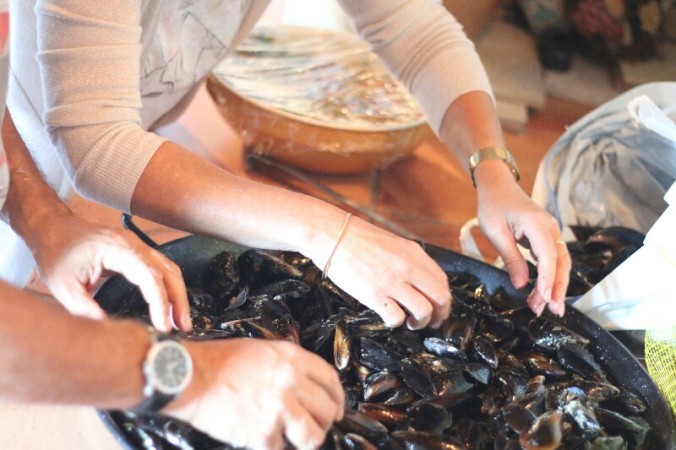
Mussel prep

The mussels ready to go onto the fire

My dad takes the brasucade very seriously
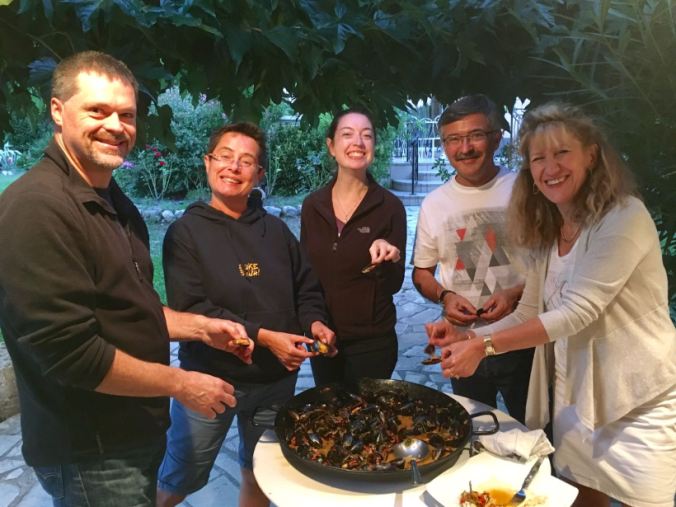
Enjoying the finished product (so delicious!)
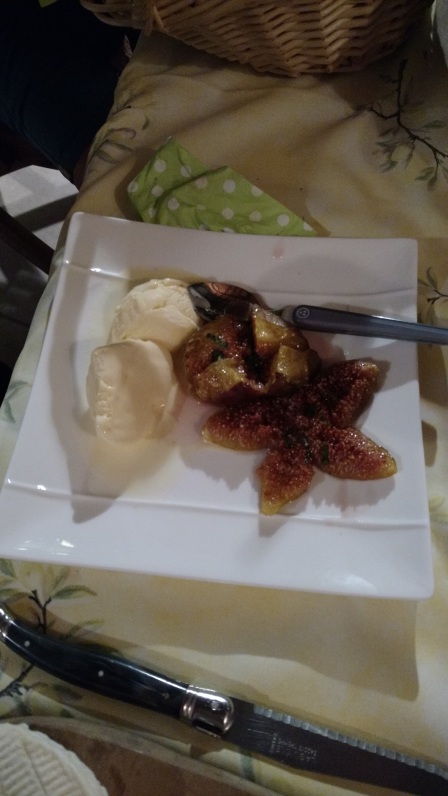
Let’s top it all off with a delicious dessert for good measure
The next morning, we woke up, had breakfast, showered, then went straight to a winery. When in France, n’est-ce pas?
St. Georges d’Orques is a small parcel of vineyards that form part of the larger Côteaux de Languedoc AOC"controlled designation of origin" — a certification granted to certain French wines (as well as other agricultural products) to indicate their place of origin, quality, style, as well as adherence... More appellation. Driving through it is a unique and incredibly picturesque experience, with small winding roads, archeological digs, wild horses, and acre upon acre of vines, each owned by a different family and passed down from generation to generation. Thomas Jefferson was said to have fallen in love with the region’s wines while he was the US Ambassador to France, and even had them imported to the White House upon becoming president!
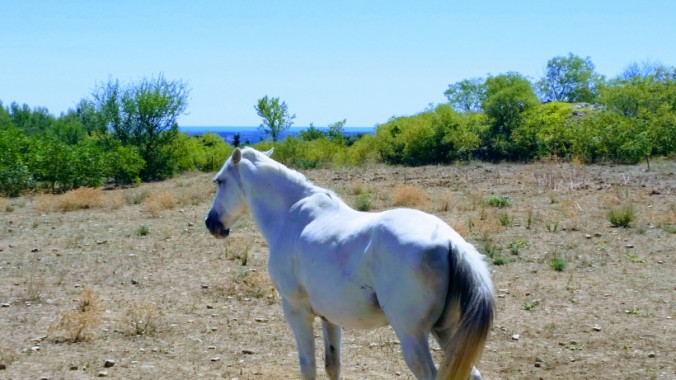
White horses are a common symbol of the Camargue region

Roman ruins of the Oppidum d’Altimurium fort (2nd century) – Languedoc has been making wines since Roman times

Belles Pierres
The Belles Pierres (“beautiful stones”) winery takes its name from both the famous Roman ruins down the road, as well as the large stone walls known as clos or clauzes that delineate properties and are a typical sight in the area.
We arrived at Belles Pierres around 11:30 a.m., “just in time for l’apéro” according to my very French father. Fine by me! As a sommelier, I know that the morning is the best time to do a wine tasting, when all the senses are most sensitive, alert, and working at their best. Belles Pierres owner and winemaker Damien Coste was there to greet us. It was mid-August, a quiet time for grape growers. The calm before the harvesting storm. An intense heat wave—known as la canicule—had recently sped many grapes all across the region to maturity, and harvest was estimated to take place around August 25 at Belles Pierres…two to three weeks earlier than usual.
Our host invited us to the tasting room, eager to share his product with his first clients of the day. He humbly introduced his small, family-run winery, which prides itself in respecting the land through organic practices, mentioning in passing that some of his wines were staples in the presidential cellar at the Palais d’Elysée, a sure sign you’ve made it in the wine world in France. As he talked about the winery and its products, we tasted through about 7 different wines, ranging from light table wines to rich sweet wines (all before lunch!). Each one had its own story and distinct flavour profile. Here are a couple of my favourites:
-
Les Clauzes de Jo rosé 2016

Clauzes de Jo rosé
This is no rosé piscine (pool-side rosé)—this is serious stuff. Syrah and mourvèdre are vinified separately and barrel aged on their leesDead yeast cells! No seriously. After yeast has fermented a wine's natural sugars, it forms a sediment called the lees. Sometimes winemakers will leave the wine on its lees ("sur... More, then blended just prior to bottling. The barrel time means the wine can even be cellared for a couple of years. The final product is a gorgeous salmon colour, mid-weight on the palate, with strawberry, peach and cranberry notes. High acidityAcidity is an important part of a wine’s structure that prevents a wine from being “flabby”. It’s what gives you that tingling sensation on your tongue and makes you salivate.... More makes this a very food-friendly wine. Les Clauzes de Jo can be found in the French presidential cellar and has won several Decanter awards.
-
Les Clauzes de Jo red 2015

Clauzes de Jo red
As with the rosé, this delicious GSM (grenache, syrah, mourvèdre) blend is part of the Clauzes de Jo line. Jo is an affectionate nod to Joseph, the patriarch of the family and Damien’s father, who is still involved in winery operations (keeping it all in the family is typical in the smaller, family-run Languedoc wineries). All the grapes for this wine are hand-picked then barrel aged for one year. The nose shows rich, dark fruit like black cherry and plum, as well as a hint of sweet spice and cigar box. On the palate it is smooth, with perceptible tanninTannins help form a wine’s structure, but generally only in red wines. Tannins come from the grape’s stems, seeds and skins, and to a lesser extent from the wood in... More. The initial flavour is black cherry, followed by the sweet spice and cigar box from the nose, with the addition of chocolate. This is a perfect fall or winter wine to pair with stews or grillades of pork chops or steak.
-
Monica – El Encuentro

Monica – late harvest red – the kiss on the label pairs nicely with the theme of this post
Syrah, grenache and muscat à petits grains noirs sit on the vine into the fall, their sugars concentrating until they are harvested in late September to mid-October. With each sip, this late-harvest red tells the story of how Damien met his late wife, Monica. Its rich and enveloping ripe dark fruit and cocoa aromas lure you in again and again. To quote my own tasting notes, “Yummy, so yummy”. Pair with black forest cake or try a contrasting regional pairing like roquefort.

Merci à Damien Coste pour la visite et la dégustation exceptionnelles!
We only spent five days in this beautiful and relatively unknown part of France, and barely scratched the surface of this amazing region known for mussels, Carcassonne and cassoulet. But that was all it took to fall in love with it. The amazing food and wine, the seaside location, the beautiful views, and the incredibly generous inhabitants make Languedoc a very appealing place to visit with so much to discover. We know we’ll be back.
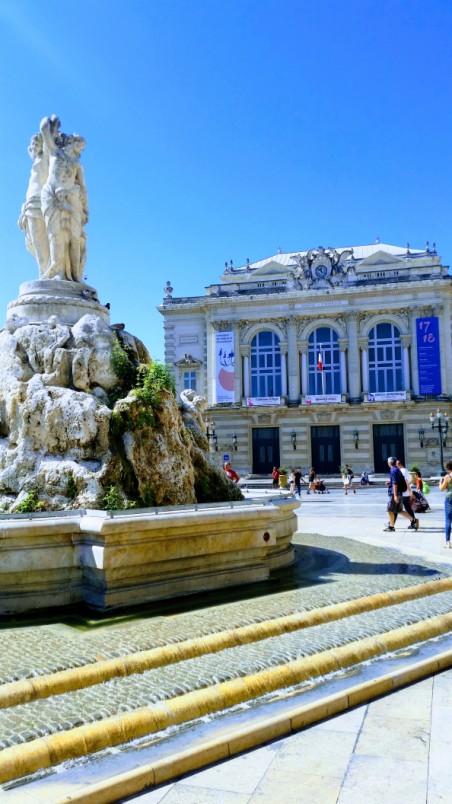
Place de la Comédie, Montpellier
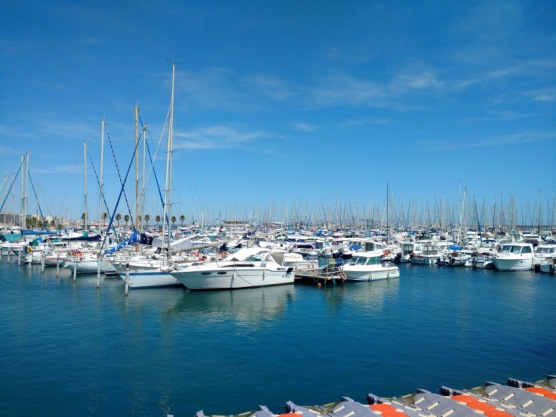
The port at Palavas-les-Flots
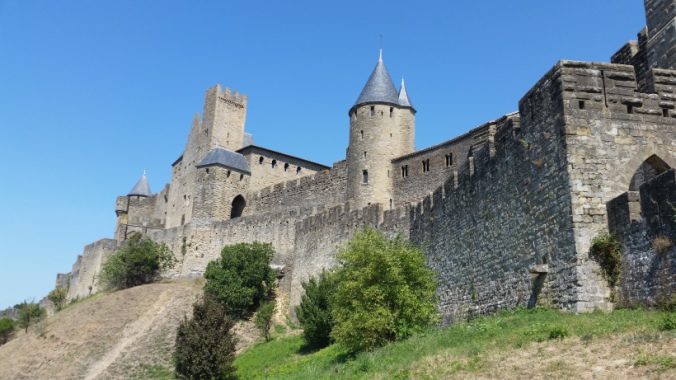
Majestic Carcassonne

When in Languedoc, cassoulet is a MUST
This post is part of a monthly blogger “gathering” called the French Winophiles. I’ve been admiring this group of wine and food bloggers from afar for a while now, and decided to take the plunge this month and join in! The Winophiles get together on Twitter once a month to share their passion for France and its wines (not to mention delicious food pairings). Please join us on Saturday, October 21 at 11 a.m. (ET) to chat about the Languedoc region using the hashtag #winophiles. You can also read all the other contributions to this theme by clicking on the links below:
Martin from Enofylz > 2014 Domaine L’Ostal Cazes “Grand Vin” Minervois La Livinière #Winophiles
Michelle from Rockin Red Blog > Say Yes to Languedoc Wine
Nicole from Somm’s Table > Domaine de Majas Côtes Catalanes Blanc with Butter Poached Salmon and White Asparagus
Wendy from A Day in the Life on the Farm > Celebrating Languedoc with Cassoulet
Gwen from Wine Predator > Grilled Cheese with 4 Affordable Wines from Occitanie: new name for a fave region in France
Jane from Always Ravenous > Rustic Sausage Kale Pasta with Languedoc Wine
Camilla from Culinary Adventures with Camilla > An Easy Dinner with Anchoïade and Mas Cavalier de Lascaux
Olivier from In Taste Buds We Trust > Boutenac: Balance in the Languedoc
Lynn from Savor the Harvest > Making Great Wines in the Languedoc-Rousillion #Winophiles
Our host Jill, from L’occasion > New Roots Along the Canal du Midi
Hope you can join us!
P.S. If you are interested in reading more about our pan-Mediterranean adventure (and the Caribbean sailing adventure that comes next), check out www.wherethewindtakesus.ca.
P.P.S. If you are in Canada and are looking to get your hands on Belles Pierres wines, check out their available selection through Cellier des Cigales, a private importer in Quebec.




Sound like an amazing trip! I would absolutely adore those mussels. And the wines sound great too. My wife and I are planning a two week trip to France next year. I’m not sure if Languedoc will make the cut (Champagne, Burgundy, Rhone and Bordeaux are the leading contenders at this point), but this post is making me have second thoughts!
Ooooh tough choices! Good luck with the decision making process. Sounds like good fodder for a blog post…
Hi Mel, when I see your pictures I want to go back there immediately 🙂
If it’s any consolation, me too!! 🙂
What a magical trip! A total dream for me. So many of my favorite things just right here – mussels, cassoulet, and of course wine!
It was definitely amazing. We were spoiled with wine from start to finish! Thanks for reading!
Thanks for jumping in this month…and what a great trip. Three kisses for you. For the reminder of how much I need cassoulet in my life this week. Definitely making some.
Thanks! I also have a favourite cassoulet recipe, but it’s never quite the same as when you’re there.
Always love to hear about trips like yours, taking off for weeks! The brasucade muscle dish- yep I’d be right there at the table with you eating them.
Definitely checking out the rest of your Mediterranean trip. Glad you joined the #winophiles for this one Mel, look forward to seeing you again ;-D
Thanks for your lovely words, Lynn! The mussels were finger-kicking good! The Languedoc food memories are quite vividly imprinted in my mind.
Good to hear about the importer in Quebec!
Great piece – it sounds like you had a wonderful trip. 🙂
Thanks for reading, Lynette! Yes, it was definitely a great trip!
This is absolutely my dream trip…Thanks for letting me live vicariously through you.
Our Med adventure was awesome! But I did learn a few things. For example, 9 weeks is maybe too long to be living out of a suitcase! And we did it all with just a carry-on!
Great great post:) your travels sound so amazing. Glorious life!
Sent from my iPhone
>
Thanks, Angie! We were definitely spoiled in Languedoc 😊
I don’t think I ever had cassoulet… it wasn’t exported all the way to Nantes. We had a feast of mussels this summer too, I love it. So simple, yet so tasty…!
Food just tastes better in France. Why can’t we get that kind of intense flavour in Canada?? Next time you go to the southwest, you gotta have cassoulet. Beans and three different kinds of meat (not so great for vegetarians sadly).